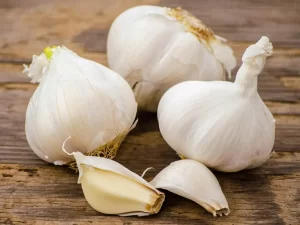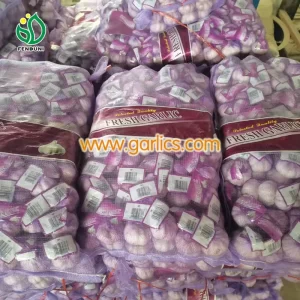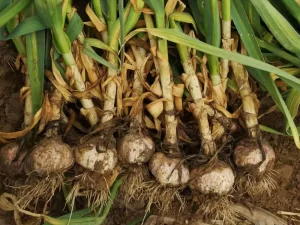Garlic is known for its solid smell and enjoyable taste. That’s why it earned a special place in kitchens worldwide. It’s a fundamental ingredient in countless culinary delights and a medicinal powerhouse. So, understanding the differences between Chinese and American garlic becomes essential.
Explore the unique characteristics of these garlic varieties, emphasizing communication simplicity and clarity!
Cultivation and Geographic Origins
Chinese Garlic

China has established itself as a garlic-producing powerhouse, with several key regions leading. Shandong, Henan, and Jiangsu provinces are primary cultivators of this flavorful bulb. These regions provide an ideal condition for garlic growth.
What are these ideal conditions?
Both climate and soil conditions matter for garlic cultivation. Mild winters and moderate rainfall create an optimal environment for the bulb’s growth. Moreover, the well-drained, nutrient-rich soils provide an ideal base for strong garlic crops.
Chinese garlic is available in various varieties. Silverskin and Hardneck are two prominent Chinese garlic.
- 1. “جلد فضي” is well-known due to its strong smell and versatility.
- 2. “Hardneck” has bold and complex flavors.
American Garlic
In contrast with China, the US also boasts its significant garlic-growing regions. California and Oregon are the primary garlic cultivation regions in the USA. The moderate climate in these areas is ideal for the garlic bulb’s growth and development.
Within the US, different garlic cultivars have harvested dedicated followings.
- 1. “California Early” garlic is popular for its mild flavor and early harvest.
- 2. While the “Inchelium Red” garlic has a rich and complex taste for food enthusiasts.
Flavor and Culinary Uses
With a spicy undertone, Chinese garlic’s flavor is often bold and intense. Its potent aroma infuses dishes with a distinct garlic essence. Chinese cuisine relies on garlic as a foundational ingredient in;
- 1. Stir-fries
- 2. Sauces
- 3. Soups
Impart their signature taste to these dishes.
In comparison, American garlic showcases a milder profile. It offers a perfect balance of flavor and aroma. Its versatility allows it to enhance dishes’ flavor without overpowering other ingredients. American culinary traditions use garlic in a variety of ways, like:
- 1. Spreads roasting
- 2. Pasta sauces and marinades.
Nutritional Benefits and Medicinal Properties
Chinese garlic is valuable to a balanced diet, enriched with essential nutrients. It is a rich source of vitamins C and B6, manganese and selenium. It also contains bioactive compounds like allicin, known for its potential health benefits.
Also, American garlic offers an array of nutritional benefits. It provides a notable amount of vitamins C and B6, calcium and potassium. Allicin and other sulfur compounds contribute to its potential medicinal properties.
The common medicinal properties are:
- 1. Maintain cardiovascular health
- 2. Support immune system
- 3. Prevent respiratory infections and the common cold
- 4. Improve digestive health
- 5. Show anti-inflammatory effects
- 6. Provide antioxidant benefits
- 7. Regulate blood sugar level
Physical Appearance
Chinese Garlic
Chinese garlic bulbs fall into the medium-sized category. This garlic varies in size due to factors like growing conditions and cultivar.
They are round with a flat bottom where the root plate attaches. The outer layer, “wrapper,” has a crisp, white appearance, giving a fresh look.
You’ll find well-organized cloves when peeling this garlic from the back. The cloves are usually medium to large. A standard Chinese garlic bulb contains 10-12 cloves. And all are well separate from the others.
American Garlic
American garlic bulb sizes range from small to large. The shape can vary from round to a little elongated, giving each bulb a unique character. This diversity results from the various garlic cultivars grown across the United States.
When looking at their garlic bulb, the cloves are organized around a central stalk. Each bulb contains about 4-6 cloves based on garlic type. While the outer skin “tunic” displays various colors, from off-white to shades of purple.
Market and Global Demand
Chinese Garlic Market

China is the largest garlic-producing country worldwide. It produces about 75% of total garlic production. That’s why it’s a significant exporter in international markets.
China exported 218,000 tons in October 2022. This rate is 7.8% higher than 2021. More than half of this is freshly produced garlic.
China’s garlic suppliers have led to important trade partnerships with many countries.
Key importers include:
- 1. United States
- 2. Japan
- 3. South Korea
- 4. European nations
Chinese garlic exporters face both opportunities and challenges.
Growing demand for garlic-infused products worldwide drives market trends. Yet, tough competition, quality issues, and varying tariffs pose great challenges.
American Garlic Market
The US has large garlic production, satisfying local and global demands. This independence leads to significant garlic exports.
According to surveys, America produces ~400 million pounds of garlic per year. In contrast, it exported 264,255 lbs of fresh garlic in 2022.
American garlic finds its way into various international markets. Major export destinations include:
- 1. Canada
- 2. Mexico
- 3. Japan
- 4. Some European countries
US garlic enjoys a positive market image for quality and reliability.
American garlic competes well against Chinese garlic globally with unique attributes. Consumers appreciate its milder flavor. This flavor makes it an ideal choice for various culinary creations.
Besides, strict US quality standards give it a competitive edge over Chinese garlic.
Environmental Impact and Sustainability
Chinese Garlic Farming Practices

Chinese garlic farming practices often involve conventional methods. It includes the use of synthetic fertilizers and pesticides.
While these practices have boosted production, they raise ecological concerns. The heavy use of chemicals can lead to soil degradation and contamination. This impacts the long-term sustainability of garlic cultivation.
The major environmental issues that China faces are:
- 1. Soil erosion
- 2. Water pollution
That is why sustainable farming is gaining popularity. Farmers are adopting organic practices. These practices include:
- 1. Discovering alternative pest control methods
- 2. Reducing the use of harmful chemicals
- 3. Promoting environmental preservation
American Garlic Farming Practices
America promotes more sustainable farming practices than conventional in the garlic industry. Many American garlic farmers promote sustainable methods. Such as
- 1. Crop rotation
- 2. Cover cropping
These methods maintain soil health and reduce the need for chemicals.
It’s because environmental protection is essential to American garlic farming. Farmers engage in conservation practices, including:
- 1. Water-efficient irrigation system
- 2. Erosion control measures
These efforts reduce the environmental impact. Also, promote the long-term viability of garlic farming in the US.
خاتمة
Chinese and American garlic farming practices differ in environmental impact and sustainability.
Chinese garlic farming faces challenges but is moving towards sustainability. In reverse, the American garlic industry embraces sustainable initiatives, promoting environmental stewardship and conservation.
We should focus on responsible farming for garlic’s sustainability and ecosystem protection. Clear communication helps us make informed choices to support environmentally friendly garlic production.
